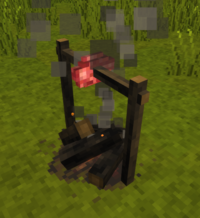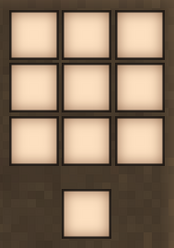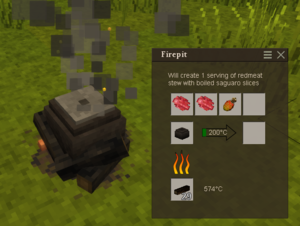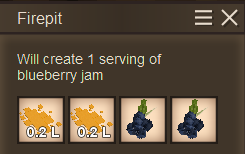Cooking/en-gb: Difference between revisions
(Created page with "===Einzelne Nahrungswerte=== {| class="wikitable sortable" |- ! Eiweiß ! Sättigung ! Gemüse ! Sättigung ! Getreide ! Sättigung ! Obst ! Sättigung |- | Gekochtes Ei || 16...") |
(Created page with "* Wenn verzehrt geben Saguaro und Honig dem Spieler Gesundheitspunkte.") |
||
| Line 35: | Line 35: | ||
|} | |} | ||
* Saguaro | * Wenn verzehrt geben Saguaro und Honig dem Spieler Gesundheitspunkte. | ||
== Basic Cooking == | == Basic Cooking == | ||
Revision as of 13:22, 17 March 2020
Ernährung und Sättigung
Aktuelle Ernährungs- und Nährstoffwerte können im Charakterfenster angesehen werden, als Voreinstellung auf 'C'.
Nährstoffe
Es gibt vier Kategorien von Nährstoffen: Eiweiß, Getreide, Gemüse und Obst. Wenn die Nährstoffanzeigen gefüllt werden, erhöht sich die maximale Gesundheit des Spielers. Der Spieler started mit 15 Basisgesundheit, welche bis auf 25 Gesundheitspunkte erhöht werden kann, indem er sich ausgewogen ernährt und alle vier Nährstoffe zu sich nimmt. Dafür ist fortgeschrittene Nahrungszubereitung nützlich, denn dies erlaubt dem Spieler Mahlzeiten mit gemischten Nährstoffen zuzubereiten (Eiweiß/Gemüse, Getreide/Gemüse, Eiweiß/Getreide, Eiweiß/Obst/Gemüse etc...). Bedenke jedoch, dass Nährstoffwerte sich nicht erhöhen, wenn der Spieler bei voller Sättigungsanzeige Nahrung zu sich nimmt.
Sättigung
Spielersättigung zeigt an, wie "hungrig" oder "wohlgenährt" ein Spieler ist, und hat einen Maximalwert von 1500. Die untere Tabelle zeigt die Sättigungswerte einzelner Nahrungsmittel an. Die Sättigungsmenge, die der Spieler durch Essen erhält ist "gleich der Summe ihrer Teile." Die Zutaten, aus denen die Gerichte hergestellt werden, bestimmen den Sättigungswert und welche Nährstoffkategorien gefüllt werden. Zusätzlich dazu verlängert sich die Zeit, bis die Sättigungsanzeige wieder abnimmt um 30 Sekunden für alle 100 Sättigungspunkte, die gefüllt werden.
Einzelne Nahrungswerte
| Eiweiß | Sättigung | Gemüse | Sättigung | Getreide | Sättigung | Obst | Sättigung |
|---|---|---|---|---|---|---|---|
| Gekochtes Ei | 160 | Wurzeln: Karotte, Pastinake, Zwiebel, Steckrübe, Rohrkolbenwurzel | 100 | Flachs | 30 | Johannisbeere, Blaubeere | 80 |
| Gekochtes Buschfleisch | 120 | Pilze (Steinpilz, Feldpilz) | 80 | Flachsbrot | 160 | Preiselbeere | 60 |
| Gekochtes Geflügel | 200 | Kürbis | 120 | Restliches Getreide | 60 | Saguaro | 60 |
| Gekochtes rotes Fleisch | 280 | Kohl | 300 | Restliches Brot | 300 | Honig | 60 |
- Wenn verzehrt geben Saguaro und Honig dem Spieler Gesundheitspunkte.
Basic Cooking
Simple cooking includes placing raw meat, bread dough, or cattail roots in the firepit. Roasting makes these 3 types of raw food edible. All other ingredients require a clay pot to be cooked.
Raw or simply cooked foods provide 10 seconds until player satiation starts to drop.
Baking Bread
To bake bread, players must have a firepit, bucket and a quern available.
Bread Dough
To create bread dough, prepare flour using a quern to grind grain.
- Open the quern GUI (RMB) and add grain into the input slot (left) of the quern.
- Hold RMB on the base of the quern to grind the grain into flour, which will appear in the output slot (right) of the quern.
- In the crafting grid, combine a bucket of water and flour to create dough. (one bucket of water creates 10 dough)
Baking
Place the dough into the input slot of the firepit and fuel the fire. (Each loaf of bread requires about one piece of firewood.) Both dough and bread loaves stack to 32.
Advanced Cooking
To prepare more wholesome meals, craft a claypot using the clay forming mechanic. Place the burned claypot into the fire pit input slot (left) to cook any of the 5 available meal types. The meal type players create is determined by which two "required" ingredients are placed into the claypot.
- To create one serving of any meal: place one of each required item into two separate claypot slots (this defines the meal type). For example, a porridge requires "two grain", so a player must add two individual pieces of grain in any two input slots in the claypot. Placing two grain in one input slot of the claypot will not create a porridge. Adding "optional" ingredients in the other two input slots of the claypot will increase the nutrition value and satiation of the meal depending on which items are added. When a valid meal recipe (combining correct ingredients) is placed into the input slots, a message will appear in the claypot dialog box informing players about what type of meal will be created after cooking.
- To cook multiple servings of a meal: increase the number of ingredient items added to all slots equally. The claypot allows players to cook up to 6 servings of any meal at a time. When creating multiple servings all the items in the input slots must be increased by the same amount, or the food will not cook!
- To fill a bowl: A bowl holds one meal portion and may be filled from a claypot or food storage crock. To fill a bowl, place the container of cooked food onto a solid surface. With the empty bowl in the active hand use RMB on the claypot or crock. Bowls and crocks may be filled with meals while the claypot is in the firepit. Bowls of food may be carried in player inventories, stored in stationary containers, and placed on shelves. Bowls cannot be filled from crocks on shelves.
- To eat a meal: Food may be consumed from a filled bowl. With the filled bowl in an active hotbar slot, eat using RMB. Players will eat until full, which may leave partial portions of food in the bowl.
- To store meals: Four portions of any cooked meal can be stored in an empty crock. Place the pot onto the ground or table and right click the pot with an empty crock to transfer meals to the storage crock. Storage crocks may be sealed for long term storage using fat or wax in the crafting grid, Crocks may also be carried in player inventories, stored in stationary containers, and placed on shelves.
Advanced Cooking Recipes
| Advanced Recipes | Meat Stew | Vegetable Stew | Porridge | Soup | Jam |
|---|---|---|---|---|---|
| Required Ingredients | 2 Poultry or Red meat | 2 Vegetables or Beans | 2 Grain | 1 Vegetable (Fresh) + 1 Water | 2 Fruit + 2 Honey |
| Optional Protein | 0 - 2 Poultry, Red meat, Egg or Beans | 0 - 2 Soy beans (pickled or fresh) | 0 - 1 Poultry, Red Meat or Egg | ||
| Optional Vegetable | 0 - 2 Vegetable (pickled or fresh) | 0 - 2 Vegetable (pickled or fresh) | 0 - 2 Vegetable (pickled or fresh) | 0 - 2 Vegetable (pickled or fresh) | |
| Optional Grain | 0 - 2 Grain | ||||
| Optional Fruit | 0 - 1 Fruit, Honey | 0 - 2 Fruit | |||
| Optional Honey | 0 - 1 Honey |
- Add water or honey with a filled bucket. Use LMB to add one portion, RMB to remove one portion.
Advanced Cooking Food Values
Meals have a 50% extra satiety bonus from the ingredients' total satiety.
| Protein | Satiation in Meal | Vegetable | Satiation in Meal | Grain | Satiation in Meal | Fruit | Satiation in Meal |
|---|---|---|---|---|---|---|---|
| Soy Bean | 240 | Roots: Carrot, Parsnip, Onion, Turnip | 150 | Flax | 120 | Currants, Blueberry | 120 |
| Egg | 200 | Cabbage | 450 | Rice | 240 | Cranberry | 90 |
| Poultry | 375 | Pumpkin | 180 | Rye | 240 | Saguarro | 90 |
| Red Meat | 420 | Mushrooms (Bolete, Field) | 120 | Spelt | 240 | Honey | 80 |
| {{{title}}} | |
|---|---|



